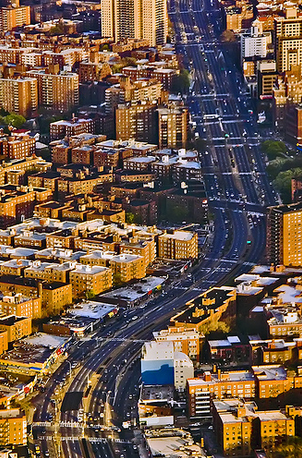Word on the street is that Queens Boulevard could be the first major arterial redesign initiated by Polly Trottenberg's DOT.

At a Friday panel on transportation equity organized by the Congress for the New Urbanism, architect John Massengale said he is working with Transportation Alternatives on conceptual designs that will spark conversation before DOT hosts workshops about the project. "The idea is that side lanes on the multi-lane boulevard become much, much slower," Massengale said. The basic framework he envisions would include wider sidewalks and a protected bike lane next to the sidewalk.
DOT has not responded to a request for comment, but a source familiar with the project confirmed that the agency will soon reach out to elected officials and community boards about remaking what's long been known as the "Boulevard of Death." Update: "Safety on Queens Boulevard is a priority for DOT," an agency spokesperson said in a statement. "We continue to engage elected officials, community boards and other local stakeholders in the coming months in a conversation about Queens Boulevard safety."
While fatalities on Queens Boulevard dropped after changes made more than a decade ago, the street still ranks as one of the borough's most dangerous streets. In May, DOT added Queens Boulevard to its arterial Slow Zone program, but did not lower its speed limit to 25 mph.
Volunteers at TA have spent years building support for a safer Queens Boulevard, with a united front of council members and growing interest from community boards along the street.
Massengale said New York will have to continue breaking new ground on street design to eliminate traffic deaths. "These new arterials, they have cut fatalities," Massengale said, referring to NYC DOT's protected bike lane and arterial traffic calming projects. "But this design is not going to get to zero, because the only way to get to zero is to slow the cars way down." Even recently redesigned streets like Second Avenue, he said, don't have design speeds that match the city's impending 25 mph speed limit.
“Good cities have a combination of streets," he said, suggesting shared space as one option that deserves more attention. “The solution on Queens Boulevard is different than the solution for West Fourth Street in the Village. There is a conversation here about transportation corridors versus walkable streets."
The focus of Friday's panel was how to extend the health and safety benefits of safer street designs to a broader swath of the city. "Design can’t solve income inequality," said Joan Byron, policy director at the Pratt Center for Community Development. "But design and policy can certainly change course and focus on areas of low income."
Despite the benefits for residents of low-income communities, complete streets can be viewed with suspicion in these neighborhoods. Karen Horry, who until recently chaired Manhattan Community Board 10's transportation committee, raised this point in a question to Byron. “A lot of communities rightly read street beautification and walkability projects with suspicion, that this is not being done for us," Byron said, before suggesting more intensive outreach to ensure a wide range of neighborhood residents are included.
"The low-hanging fruit in terms of pedestrian space and walkable streets is in the white neighborhoods, and that's got to change," Byron said. "The time that our officials and our designers and our activists spend buffing up areas that are already pretty pleasant and nice comes at a cost to areas that are pretty appalling."





